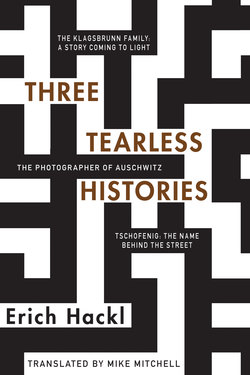Читать книгу Three Tearless Histories - Erich Hackl - Страница 9
На сайте Литреса книга снята с продажи.
Оглавление4
THE PILZGASSE is the title of the memories Grete Gabmeier-Grach wrote down ten or more years ago for her grandchildren. A thin volume with a few photos that Frau Gabmeier gave to me and Victor to read when we visited her in December 2011. On our way there we passed an overgrown plot of land on which Villa Klagsbrunn, badly damaged by a bomb that hit it on March 12, 1945, had stood until the late fifties then had to make way for a modest summer house, until that was also torn down or simply allowed to fall into ruin.
Grete Gabmeier was born in 1927 and is the last person we could find in Vienna who still remembers the Klagsbrunn family—Leo and his wife and children, not his parents, who were already dead by the time Grete, holding her mother’s or her aunt’s hand, looked around the villa for the first time. Right behind the front door was the larder with an ice-box full of blocks of ice, then a windowless corridor with, on the one side the kitchen, very narrow because a bathroom had been built in, and the dining room, on the other the office and the so-called middle room, from which you could go out onto the veranda, which didn’t exist in 1904. On the second floor were the balcony room and two little attic rooms—the bedrooms for the family of four.
From the entries in Lehmann’s Directory we know that after the First World War Leo took over the premises of his father’s firm. But before that, after his training as a chemist, he ran a wholesale business for household goods and was a partner in the Buche Charcoal Trading Corporation. Initially his new firm, Leopold Klagsbrunn Chemist, also sold chemical products, but then he restricted himself to dealing in charcoal, coal and coke. He had several employees, eventually six, “all of them Aryan,” as he was to be compelled to declare.
Leo is a striking figure in Floridsdorf, and not just because of his height, he’s almost 6’ 6” tall, but athletic as well, affable and charming; at the Gänsehäufel lido on the Danube the heads of the young women turn when he takes a run-up on the wooden planks and does a racing dive into the water. To their disappointment, in October 1911 he marries Friederike ‘Fritzi’ Kohn from the Leopoldstadt district who’s one year older and two heads shorter than him. Their first child, Karl Peter, is born on May 24, 1913, their second, Kurt Paul, on May 6, 1918. (It’s a family tradition to give their sons two first names, either because the parents can never agree or because they want to let their children have the opportunity of deciding for themselves whether to take the one or the other; Karl Peter will use his second name.) In December 1926 the police authorities in Vienna grant Leo Klagsbrunn “permission to drive motor vehicles with an internal combustion engine unaccompanied;” in 1930 the Vienna Football Association issues an identity card for him showing that he is the Deputy Chairman of the First League, the top Austrian division. The photos on the card and driver’s license show a slim young man with thick hair combed back and a carefully trimmed walrus mustache. He still has the melancholy, wistful look of his mother, who died in June 1914, ten years before her husband.
